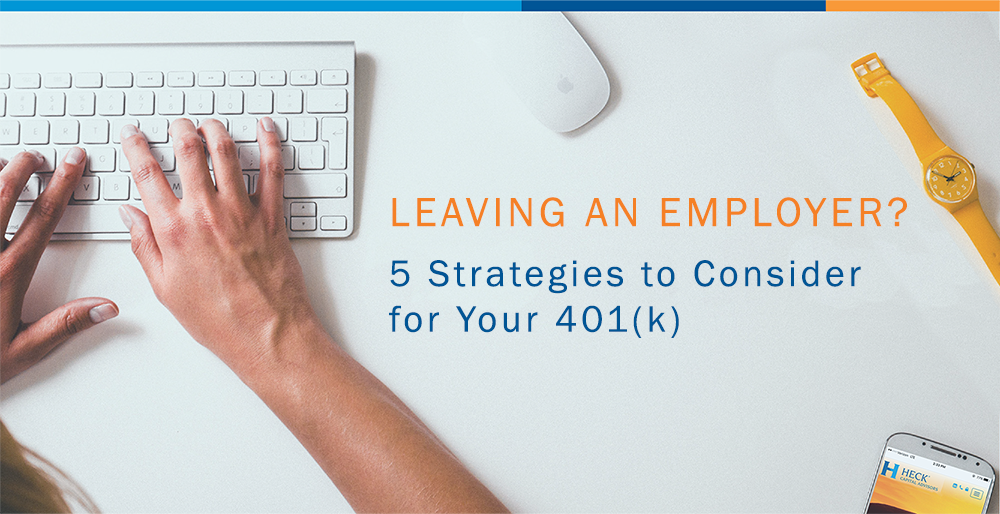Leaving an Employer? 5 Strategies to Consider for Your 401(k)
Over the past three decades, many employers have transitioned away from defined-benefit plans (pensions), and moved towards defined-contribution plans (401(k) or 403(b)). Unlike a pension, funding a 401(k) and assuming risk from a portfolio falls on the individual, not guaranteeing a set payout. While this may shift funding responsibility off of employers, it places more responsibility on the individual employee to save for retirement successfully. Because 401(k) plans represent an estimated 25-30% of retirement income, it is even more critical that you make a well informed decision with your 401(k) when leaving an employer.1
One of the benefits of a company sponsored 401(k) plan is its portability, or the ability to move your 401(k) when you transition jobs. It is crucial for your retirement plan that you continuously monitor your 401(k) and make a careful decision when changing employers. Depending on which option you choose, some potential benefits of a portable 401(k) include widening your investment selection, receiving professional management and advice, and potentially reducing fees. If you do not properly monitor or change your 401(k) after leaving an employer, it is possible that you may lose track of previous investments and your risk return profile may change, potentially making the investment allocation unsuitable over time.
Please see your 5 potential strategies for your 401(k) when leaving an employer:
1. IRA Rollover
An IRA rollover moves your 401(k) retirement savings to an Individual Retirement Account (IRA). This option allows you to avoid income taxes and penalties, and your assets remain tax-deferred. Individuals who choose this option have the opportunity to obtain more control over their retirement savings and can avoid the hassle of future job changes. An IRA rollover will most likely provide you with a broader range of investment choices and the opportunity to consolidate multiple retirement accounts. It also provides the opportunity to seek out professional investment management from an investment advisor. If you are considering an IRA rollover, it is also important to note that loans are not allowed and fees may be higher than what the previous employer plan charged. An IRA also requires minimum distributions at age 70.5 regardless of employment status.
2. Leave Money in Former Employer Plan
Leaving your money at your old employer is a simple option that allows you to avoid taxes, potentially maintain lower fees, and have the possibility of withdrawing money after age 55 without penalties. An estimated 30% of Americans who change jobs either fail to, or chose not to rollover their retirement savings into an IRA or new 401(k).2 If you have a considerable amount saved and you are confident in your current plan, leaving your money may be a good option. However, your investment selection may remain limited, and your ability to leave assets in the plan is subject to policies and contractual terms. Some plans may not provide periodic payments to retirees and you may miss out on important information about plan changes. It also puts the responsibility on the individual to keep track of several plans including changing allocations as risk and return characteristics change over time.
3. Move Assets into New Employer Plan
Moving your assets to your new employer’s plan could be a great option for you if the new 401(k) plan is cost effective and well-constructed. This option will potentially allow you to avoid taxes and penalties, take out new loans, or make additional contributions with a company match. Additionally, your assets will remain tax-deferred. However, it is important to consider that your investment options could be more limited and assets are subject to your new employer’s policies and plan design. Many employers require a certain number of months at their firm before an employee can enroll in a retirement plan and may have a vesting period before an employee becomes completely vested in their plan.
4. “Cash Out”
If you choose to withdraw the assets from your 401(k), you will be able to freely use remaining funds for other purposes. However, these assets are subject to taxes and potential penalties which could be detrimental to your retirement savings. More specifically, 20% of your assets are automatically withheld for taxes upon distribution, an additional 10% penalty tax may apply if you are under 59.5 years, and federal/state/local income taxes may apply. If you have a significant amount in an old account, the tax burden of the withdrawal will likely be a substantial portion of your savings. In the long term, you will be missing out on what could have been a tax-deferred growth of those assets.
5. Roth IRA Conversion
A Roth IRA conversion transfers part or all of your 401(k) into a Roth IRA. Doing so means that future withdrawals are tax-free, and there is no required minimum distribution on Roth IRA assets at age 70.5. This option can also potentially provide you with income tax diversification in retirement. However, your pre-tax amount is included in your gross income in the year of conversion, subject to the aggregation rule. The aggregation rule specifies that when determining the consequences of an IRA distribution, the total value of all IRA accounts must be added together for the purpose of tax calculations. With this option, it is also strongly recommended that you have sufficient taxable assets to pay income taxes.
Talk to a Professional
If you are leaving an employer and have to make a decision regarding your 401(k), take your time to consider all of your options. While all strategies listed above offer potential benefits and drawbacks, there is no ‘one shoe fits all’ option. Because your goals, savings, and future plans are unique, it is wise to discuss which strategy is right for you with your financial advisor to ensure you make the most well informed decision.
1https://www.fool.com/retirement/2017/10/30/20-retirement-stats-that-will-blow-you-away.aspx
2https://www.prnewswire.com/news-releases/ing-direct-usa-survey-complexity-and-confusion-cause-americans-to-leave-big-retirement-money-at-past-jobs-106442578.html
Authored by Michael Bogard, CFA on June 28, 2018
About the Author: Michael Bogard, CFA is a Business Development / Client Relationships Senior Associate at Heck Capital Advisors. Michael earned the right to use the Chartered Financial Analyst® (CFA®) designation after completing the program in 2018, fulfilling the work experience requirements, and gaining acceptance as a member of the CFA Institute. The Chartered Financial Analyst® (CFA®) charter gives a strong understanding of advanced investment analysis and real-world portfolio management skills. CFA® and Chartered Financial Analyst® are registered trademarks owned by CFA Institute.


